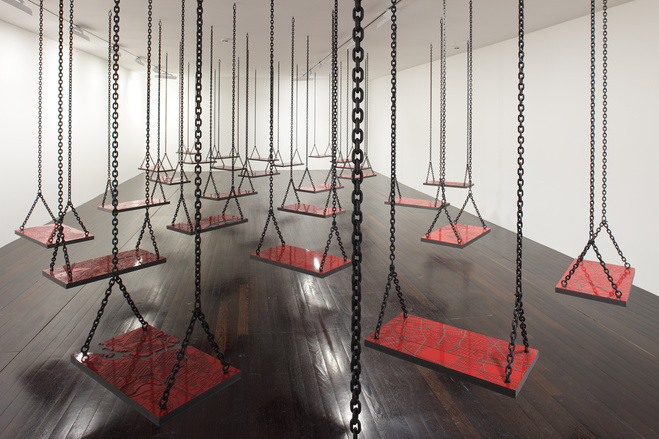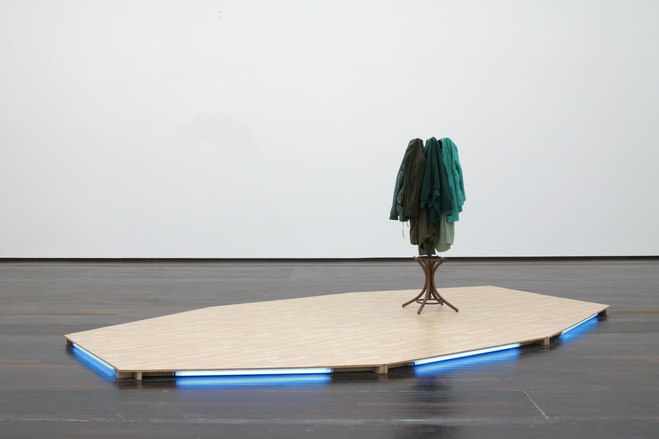Persona Grata was an art exhibition presented by Musée de l’histoire de l’immigration and MAC VAL (Musée d’art contemporain du Val-de-Marne) (ArtFacts). Located in Paris, France between October 2018 to 2019, this art exhibit expressed the sentiments of immigrants and their post-immigration lives (ArtFacts). Specifically, the exhibition highlights the divide between the French and the migrant, which has been long standing in the history of France. After World War II, the French government established policies to facilitate immigration into the country to provide a larger manufacturing and workforce to stimulate the economy (Grenon). The jobs that these immigrants were working were menial and required no formal education, leaving the majority of migrants uneducated and illiterate (Grenon). This prevented them from assimilating into French society and started the prevalence of the social divide between the immigrant and the French (Grenon). This barrier also prevents second generation immigrants
from fully assimilating, or being viewed as assimilated into French culture. According to the INSEE, a second generation immigrant is defined as a “person who is born in France with at least one immigrant parent,” (INSEE). This coincides closely with the European Commission’s definition, “a person who was born in and is residing in a country that at least one of their parents previously entered as a migrant”, and therefore for the purpose of this paper, a second generation immigrant will be defined as such (European Commision).
A second generation immigrant lacks a so-called cultural citizenship; they are French, by legal definition, but lack the cultural acceptance of French society. As Beaman describes, the distinction between legal citizenship and cultural citizenship is “being a French citizen and actually being accepted as French by others” (Beaman 37). One way to understand this cultural divide is through the lens of policy, as
displayed in Persona Grata. An important fact to remember when discussing French immigration policy is, as Dennison and Taló describe,
The French see cultural assimilation as more important when deciding who should be allowed to immigrate than economic self-sufficiency.
Dennison and Taló.
This obviously greatly alters how France must address policy issues, and emphasizes the importance of cultural assimilation in the immigrant experience, and the second generation immigrant experience.
Traditional assimilationist policies were first introduced in the
Post-Colonial era, and were one of the staples of French colonial rule; many of the countries under previous French colonial rule are now countries of origin for many French immigrants (Dennison and Talò). During the 1960’s and 70’s, assimilation was very much still the focus of immigration policies, and it was not until the mid-1980’s that more multicultural policies began encouraging immigrants to maintain their own beliefs (Dennison and Talò). These came at a price: increased closed border policies and the lessening of need for factory workers due to deindustrialization (Dennison and Talò). Now, French immigration policies are largely addressed through connections to the French Republican identity and multiculturalism (Dennison and
Talò).

As shown in Figure 1, many of these policies estrange migrants from traditional French society. The solidarity of the individual swings all in the same location could express the feeling of many second generation immigrants; one of loneliness and isolation from each other, and France as a whole.
Cultural assimilation in France, and maintaining the French national identity are highly important to French culture. This extends to the second generation of immigrants as well, as being accepted as French, from a cultural citizenship perspective, is one of the main
barriers in their assimilation process.
One example of policy affecting second generation immigrants is the debate of whether Islamic minors in France should be allowed to wear a hijab in public. This measure was passed by the French Senate in 2021, banning anyone under the age of 18 from wearing a hijab in public (Beardsley). This argument came in light of the next presidential election in France, as the conservative right had seen a large shift of their voter population to the far right, and in order to
win back those votes, must propose more controversial legislation (Beardsley).
Now this stems an even larger debate of whether minority groups, consisting of second generation immigrants, should be used and stigmatized in a political battle. By this example, it is clear to see that as Katz and Redmond from UNICEF write, “there has been a tension between government efforts aimed at the inclusion of immigrants and government efforts aimed at controlling immigration” (Katz and Redmond 46). They go on to describe how this tension tends to emphasize the cultural, ethnic, and identity issues surrounding immigration rather than diminish them. As Hamilton et al. mentions, some of these issues include “immigration, religion, France’s colonial history, emerging multiculturalism, domestic labor needs, and the broader context of post-September 11 security politics” (Hamilton et al.).

In Figure 2, the solo placement of the coat hanger reminds one of a Muslim woman in France. Adorned with her own clothing, she is left alone in society, wearing her clothing in plain sight, but completely isolated from those around her. From the perspective of a second generation immigrant, this isolation is often felt even among their peers. The ban of the hijab is a clear example of this; an attempt to unify the “French” youth is, in reality, just showcasing the religious injustice Islamic people in France have to face due to a political battle out of their control. Yet, whether this new law enforces French principles of secularism and republicanism in France or rather responds to political concerns regarding Islamic extremist groups, immigrants in France are part of those caught in the crossfire (Hamilton et al.).
A natural follow up to this argument would be to question how or why these policies came into power in such large volume. As Katz and Redmond from UNICEF describe,
French institutions have failed to confront head on the differential discriminatory treatment […] faced by many second-generation children and youth.
Katz and Redmond 46.
The institutionalization of the policy differences towards second generation immigrants marginalized the second generation, and further prevented their assimilation to French society. These policies also give the native French population debatable reason for rejecting these immigrants as assimilation is a two way street; both groups must fully accept each other. Figure 1 exemplifies this; the multitude
of empty chairs could also be seen as French society as a whole, and the emptiness of the taken seats the unity of French society. France’s creation of policy towards immigration has not only caused immigrants to feel estranged in a political sense, but also in a social setting as many French people use this as an excuse for unjust treatment.
Clearly, the structure of France as a country and its history has greatly altered attitudes towards immigrants and immigration policy. Second generation immigrants in France are searching for a so-called cultural citizenship, an imaginative, faux right-of-passage associated with the level of assimilation into French society. Persona Grata was a French curated art exhibit designed to display these hard to describe feelings in an attempt to bring French society to a unified front, immigrants included. The challenging part of obtaining this necessary cultural
citizenship is that both the immigrant, and the French people need to work together towards the common, which oftentimes, does not happen.